商学部(塾外用) - 慶應義塾大学-塾生HP
商学部(塾外用) - 慶應義塾大学-塾生HP
商学部(塾外用) - 慶應義塾大学-塾生HP
You also want an ePaper? Increase the reach of your titles
YUMPU automatically turns print PDFs into web optimized ePapers that Google loves.
Japanese life, and literature was no exception. Some savored the sharp<br />
break with the past, while others looked back on their own cultural<br />
heritage for inspiration and continuity. We will focus on the development<br />
of the modern novel though the works of such writers as Natsume Soseki,<br />
Mori Ôgai, Akutagawa Ryûnosuke, Kawabata Yasunari, Tanizaki<br />
Junichirô and Mishima Yukio. Modern film adaptations will also be<br />
introduced.<br />
Textbooks:<br />
Instructions and materials are provided on the class website<br />
(www.armour.cc/mezame.htm).<br />
Reference Books:<br />
A list of useful links and references is available on-line.<br />
JAPANESE LITERATURE 2credits (Fall)<br />
日本の文学 2単位 (秋学期)<br />
Japanese Literature<br />
Professor, Faculty of Letters ARMOUR, ANDREW J.<br />
文学部教授 アーマー, アンドルー J<br />
Course Description:<br />
This course is intended to cover the history of Japanese literature from<br />
earliest times up to the modern era. Starting with the writing system, we<br />
will trace the conspicuous developments in poetry, prose and drama<br />
through the Nara, Heian, Kamakura, Muromachi and Edo periods.<br />
Included are such works as the Manyôshû, Genji monogatari, Heike<br />
monogatari, Oku-no-hosomichi and Sonezaki shinjû.<br />
Textbooks:<br />
Students will be presented with materials in class or via the class<br />
website (www.armour.cc/jlit.htm).<br />
Reference Books:<br />
A list of useful links and references is available on-line.<br />
INTRODUCTION TO MODERN JAPANESE ART AND VISUAL<br />
CULTURE 2credits (Fall)<br />
日本の近現代美術 2単位 (秋学期)<br />
Introduction to Modern Japanese Art and Visual Culture<br />
Lecturer MURAI, NORIKO<br />
講師 村井 則子<br />
Course Description:<br />
This course explores the history of Japanese art from the midnineteenth<br />
century to the present. Visual culture has played a central role<br />
in providing modern Japan with a cultural, social, and psychological<br />
identity. We will study the significance of modernity and modernism in<br />
various media including painting, sculpture, photography, performance<br />
and architecture. We will also consider issues related to gender,<br />
imperialism, and commodity consumption in the context of visual<br />
representation.<br />
Textbooks:<br />
A course reader will be available for your purchase from the copy<br />
department on the 2nd floor of the university co-op.<br />
INTRODUCTION TO JAPANESE ART HISTORY 2credits<br />
(Spring)<br />
日本美術史入門 2単位 (春学期)<br />
From Ancient to the Medieval Periods<br />
古代―中世<br />
Lecturer SHIRAHARA, YUKIKO<br />
講師 白原 由起子<br />
Course Description:<br />
This course explores the history of Japanese art from the sixth century<br />
to the seventeenth century, taking up the issues how imagery and<br />
symbolism, decorative styles and various techniques were introduced<br />
from the continent, transformed to be Japanese original. Each class will<br />
focus on one or a few artworks, about which the function, iconology,<br />
technique and art historical meaning will be discussed.<br />
Textbooks:<br />
No text book for the course.<br />
92<br />
Reference Books:<br />
Information about reference books will be handed out on the first day<br />
of class.<br />
ARTS/ART WORKSHOP THROUGH CROSS-CULTURAL<br />
EXPERIENCE 2credits (Fall)<br />
アートワークショップ/日本のアートと文化 2単位 (秋学期)<br />
With a focus on Japanese Art<br />
Lecturer HISHIYAMA, YUKO<br />
講師 菱山 裕子<br />
Course Description:<br />
This is a course designed to provide both international and Japanese<br />
students who are interested in art from comparative culture or intercultural<br />
communication perspectives with student-centered learning experience of<br />
Japanese art. Thus students in this course will engage in diverse activities<br />
both in and outside of class within this multicultural student body. The<br />
activities include workshops, field trips, and research. The goal of this<br />
workshop is to give students a firm grounding in cultural, social,<br />
historical, and practical aspects of art in contemporary Japan.<br />
INTRODUCTION TO JAPANESE CINEMA 1 2credits<br />
(Spring)<br />
日本映画入門1 2単位 (春学期)<br />
Japanese cinema from the beginnings to the 1960s<br />
Associate Professor, Faculty of Economics<br />
AINGE, MICHAEL W.<br />
経済学部准教授 エインジ, マイケル W<br />
Course Description:<br />
This is an introductory course that examines Japanese cinema until the<br />
1960s, from the perspectives of history, authorship, genre, and film art.<br />
Though by no means comprehensive due to time limitations, this course<br />
will provide: a) an overview of the first half-century of Japanese film; b) a<br />
familiarity with some major directors and film genres; and c) some<br />
fundamental critical and technical concepts for analyzing the films.<br />
Students will learn to distinguish between personal taste (“I liked this<br />
film,” “I hated it”) and evaluative judgment (using various intellectual and<br />
artistic standards to analyze a film). Needless to say, issues related to<br />
cultural differences will arise throughout the semester, and will no doubt<br />
form an important part of class discussions.<br />
Textbooks:<br />
Excerpts from various texts<br />
Reference Books:<br />
1. Bordwell, David and Thompson, Kristin. Film Art: An Introduction,<br />
7th edition (NY, McGraw-Hill, 2004)<br />
INTRODUCTION TO JAPANESE CINEMA 2 2credits (Fall)<br />
日本映画入門2 2単位 (秋学期)<br />
Developments since the 1960s<br />
Associate Professor, Faculty of Economics<br />
AINGE, MICHAEL W.<br />
経済学部准教授 エインジ, マイケル W<br />
Course Description:<br />
This is an introductory course that examines Japanese cinema since the<br />
1960s, from the perspectives of history, authorship, genre, and film art.<br />
Though by no means comprehensive due to time limitations, this course<br />
aims to provide students with: a) an overview of major developments<br />
since the 1960s in Japanese film; b) a familiarity with major directors and<br />
film genres; and c) an introduction to fundamental critical and technical<br />
concepts for discussing films. They will learn to distinguish between<br />
personal taste (“I liked this film,” “I hated it”) and evaluative judgment<br />
(using various intellectual and artistic standards to analyze a film).<br />
Needless to say, issues related to cultural differences will arise throughout<br />
the semester, and no doubt form an important part of class discussions.<br />
Completion of the spring semester course in Japanese Film until the<br />
1960s, while highly desirable, is not a prerequisite for registration.




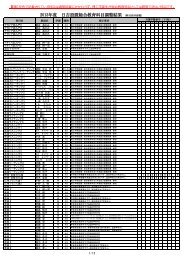
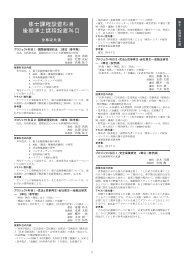
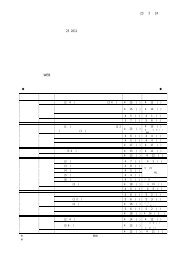
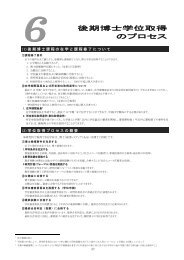
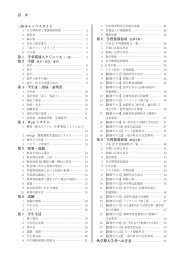



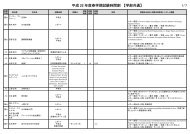

![文学部時間割表[2 ・3年生(07学則)]](https://img.yumpu.com/21046130/1/184x260/2-307.jpg?quality=85)

